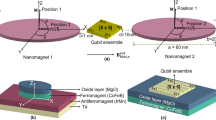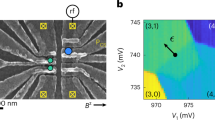Abstract
Semiconductors are ubiquitous in device electronics, because their charge distributions can be conveniently manipulated with voltages to perform logic operations. Achieving a similar level of control over the spin degrees of freedom, either from electrons or nuclei, could provide intriguing prospects for both information processing and the study of fundamental solid-state physics issues. Here we report procedures that carry out the controlled transfer of spin angular momentum between electrons—confined to two dimensions and subjected to a perpendicular magnetic field—and the nuclei of the host semiconductor, using gate voltages only. We show that the spin transfer rate can be enhanced near a ferromagnetic ground state of the electron system, and that the induced nuclear spin polarization can be subsequently stored and ‘read out’. These techniques can also be combined into a spectroscopic tool to detect the low-energy collective excitations in the electron system that promote the spin transfer. The existence of such excitations is contingent on appropriate electron–electron correlations, and these can be tuned by changing, for example, the electron density via a gate voltage.
This is a preview of subscription content, access via your institution
Access options
Subscribe to this journal
Receive 51 print issues and online access
$199.00 per year
only $3.90 per issue
Buy this article
- Purchase on Springer Link
- Instant access to full article PDF
Prices may be subject to local taxes which are calculated during checkout







Similar content being viewed by others
References
Prinz, G. A. Magnetoelectronics. Science 282, 1660–1663 (1998).
Bennett, C. H. & DiVincenzo, D. P. Quantum information and computation. Nature 404, 247–255 (2000).
Steane, A. Quantum computing. Rep. Prog. Phys. 61, 117–173 (1998).
Ekert, A. & Jozsa, R. Quantum computation and Shor's factoring algorithm. Rev. Mod. Phys. 68, 733–753 (1996).
Grover, L. K. Quantum mechanics helps in searching for a needle in a haystack. Phys. Rev. Lett. 79, 325–328 (1997).
Cirac, J. I. & Zoller, P. Quantum computations with cold trapped ions. Phys. Rev. Lett. 74, 4091–4094 (1995).
Cory, D. G., Fahmy, A. F. & Havel, T. F. Ensemble quantum computing by nuclear magnetic resonance spectroscopy. Proc. Natl Acad. Sci. USA 94, 1634–1639 (1997).
Gershenfeld, N. A. & Chuang, I. L. Bulk spin resonance quantum computation. Science 275, 350–356 (1997).
Kane, B. E. A silicon based nuclear spin quantum computer. Nature 393, 133–137 (1998).
Loss, D. & DiVincenzo, D. P. Quantum computation with quantum dots. Phys. Rev. A 57, 120–126 (1998).
Kikkawa, J. M. & Awschalom, D. D. All optical magnetic resonance in semiconductors. Science 287, 473–476 (2000).
Kawakami, R. K. et al. Ferromagnetic imprinting of nuclear spins in semiconductors. Science 294, 131–134 (2001).
Wald, K. W., Kouwenhoven, L. P., McEuen, P. L., van der Vaart, N. C. & Foxon, C. T. Local dynamic nuclear polarisation using quantum point contacts. Phys. Rev. Lett. 73, 1011–1014 (1994).
Abragam, A. The Principles of Nuclear Magnetism 354–423 (Oxford Univ. Press, Oxford, 1961).
Ando, T., Fowler, A. B. & Stern, F. Electronic properties of two-dimensional systems. Rev. Mod. Phys. 54, 437–672 (1982).
Eom, J. et al. Quantum Hall ferromagnetism in a two-dimensional electron system. Science 289, 2320–2323 (2000).
Smet, J. H., Deutschmann, R. A., Wegscheider, W., Abstreiter, G. & von Klitzing, K. Ising ferromagnetism and domain morphology in the fractional quantum Hall regime. Phys. Rev. Lett. 86, 2412–2415 (2001).
Côté, R. et al. Collective excitations, NMR, and phase transitions in skyrme crystals. Phys. Rev. Lett. 78, 4825–4828 (1997).
Das Sarma, S. & Pinczuk, A. (eds) Perspectives on Quantum Hall Effects (Wiley, New York, 1996).
Girvin, S. M. in Topological Aspects of Low Dimensional Systems (eds Comtet, A., Jolicoeur, T., Ouvry, S. & David, F.) 53–175 (Springer, Berlin, and EDP Sciences, Les Ulis, 1999).
Barrett, S. E., Dabbagh, G., Pfeiffer, L. N., West, K. W. & Tycko, R. Optically pumped NMR evidence for finite-size skyrmions in GaAs quantum wells near Landau level filling ν = 1. Phys. Rev. Lett. 74, 5112–5115 (1995).
Heinonen, O. (ed.) Composite Fermions (World Scientific, Singapore, 1998).
von Klitzing, K., Dorda, G. & Pepper, M. New method for high-accuracy determination of the fine-structure constant based on the quantized Hall resistance. Phys. Rev. Lett. 45, 494–497 (1980).
Tsui, D. C., Stormer, H. L. & Gossard, A. C. Two-dimensional magnetotransport in the extreme quantum limit. Phys. Rev. Lett. 48, 1559–1562 (1982).
Laughlin, R. B. Anomalous quantum Hall effect: an incompressible quantum fluid with fractional charge excitations. Phys. Rev. Lett. 50, 1395–1398 (1983).
Jungwirth, T. & MacDonald, A. H. Pseudospin anisotropy classification of quantum Hall ferromagnets. Phys. Rev. B 63, 035305–035314 (2001).
Cho, H. et al. Hysteresis and spin transitions in the fractional quantum Hall effect. Phys. Rev. Lett. 81, 2522–2525 (1998).
Piazza, V. et al. First order phase transition in a quantum Hall ferromagnet. Nature 402, 638–641 (1999).
De Poortere, E. P., Tutuc, E., Papadakis, S. J. & Shayegan, M. Resistance spikes at transitions between quantum Hall ferromagnets. Science 290, 1546–1549 (2000).
Kronmüller, S. et al. New type of electron nuclear-spin interaction from resistively detected NMR in the fractional quantum Hall effect regime. Phys. Rev. Lett. 82, 4070–4073 (1999).
Hashimoto, K., Muraki, K., Saku, T. & Hirayama, Y. Longitudinal resistance anomaly around the 2/3 filling factor observed in a GaAs/AlGaAs single heterostructure. Physica B 298, 191–194 (2001).
Sondhi, S. L., Karlhede, A., Kivelson, S. A. & Rezayi, E. H. Skyrmions and the crossover from the integer to the fractional quantum Hall effect at small Zeeman energies. Phys. Rev. B 47, 16419–16426 (1993).
Brey, L., Fertig, H. A., Côté, R. & MacDonald, A. H. Skyrme crystal in a two-dimensional electron gas. Phys. Rev. Lett. 75, 2562–2565 (1995).
Tycko, R., Barrett, S. E., Dabbagh, G., Pfeiffer, L. N. & West, K. W. Electronic states in gallium arsenide quantum wells probed by optically pumped NMR. Science 268, 1460–1463 (1995).
Bayot, V., Grivei, E., Melinte, S., Santos, M. B. & Shayegan, M. Giant low temperature heat capacity of GaAs quantum wells near Landau level filling ν = 1. Phys. Rev. Lett. 76, 4584–4587 (1996).
Acknowledgements
We thank A. Stern and L. Brey for discussions, and M. Bichler for technological assistance. This work was supported by the German Ministry of Science and Education (BMBF) and the German Science Foundation (DFG).
Author information
Authors and Affiliations
Corresponding author
Ethics declarations
Competing interests
The authors declare no competing financial interests.
Rights and permissions
About this article
Cite this article
Smet, J., Deutschmann, R., Ertl, F. et al. Gate-voltage control of spin interactions between electrons and nuclei in a semiconductor. Nature 415, 281–286 (2002). https://doi.org/10.1038/415281a
Received:
Accepted:
Issue Date:
DOI: https://doi.org/10.1038/415281a
This article is cited by
-
Spin phase diagram of the interacting quantum Hall liquid
Nature Physics (2020)
-
Solids of quantum Hall skyrmions in graphene
Nature Physics (2020)
-
Spin pumping from nuclear spin waves
Nature Physics (2019)
-
Electrically controlled nuclear polarization of individual atoms
Nature Nanotechnology (2018)
-
Scanning nuclear resonance imaging of a hyperfine-coupled quantum Hall system
Nature Communications (2018)
Comments
By submitting a comment you agree to abide by our Terms and Community Guidelines. If you find something abusive or that does not comply with our terms or guidelines please flag it as inappropriate.



